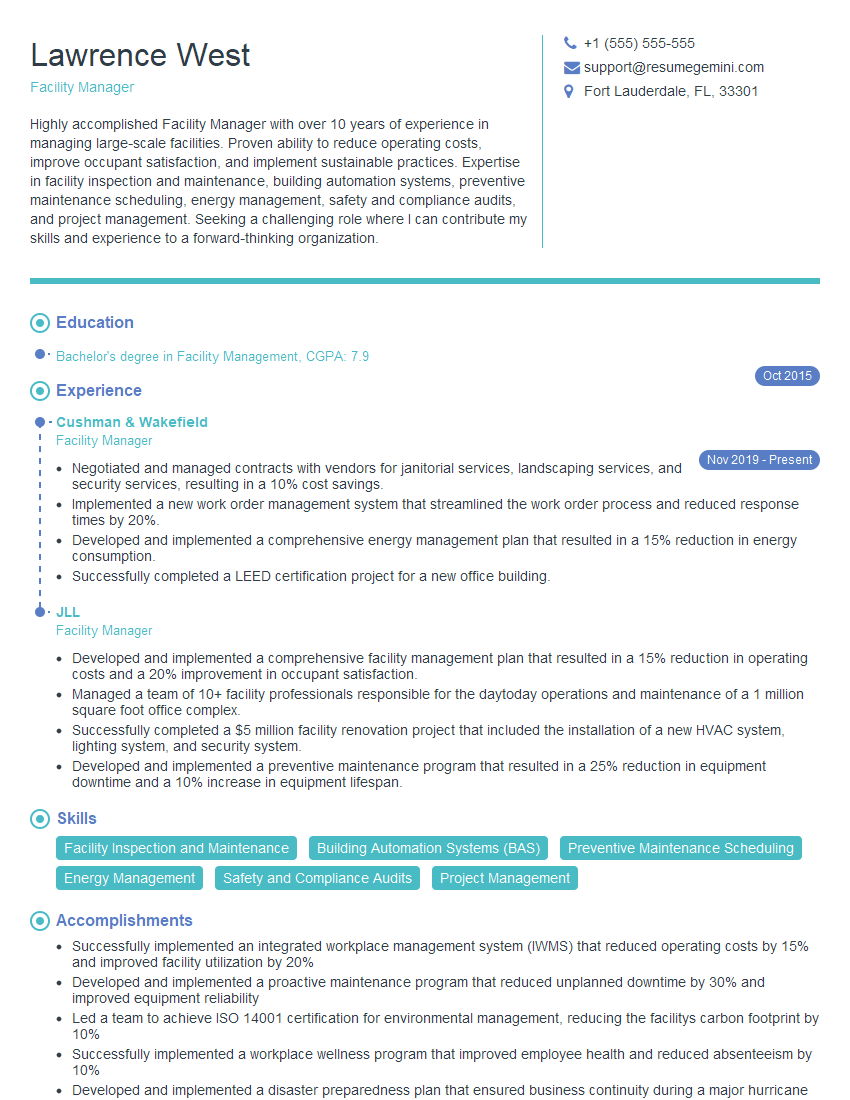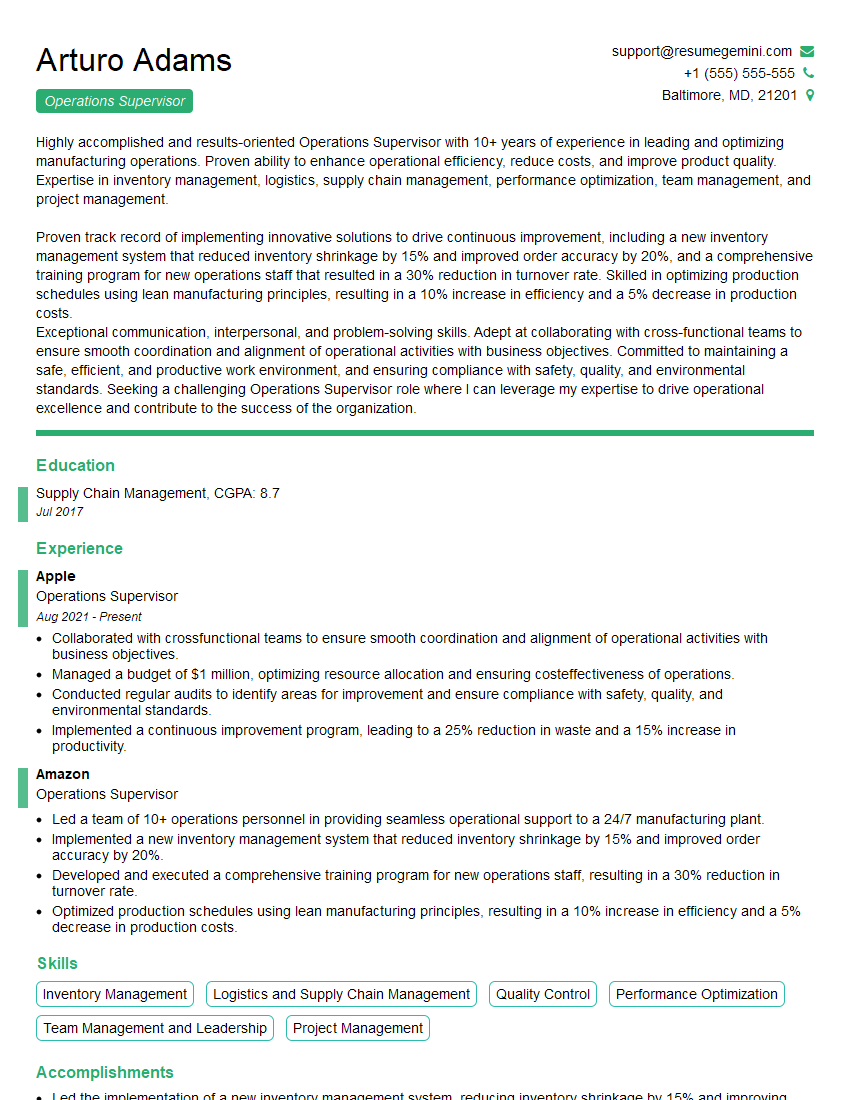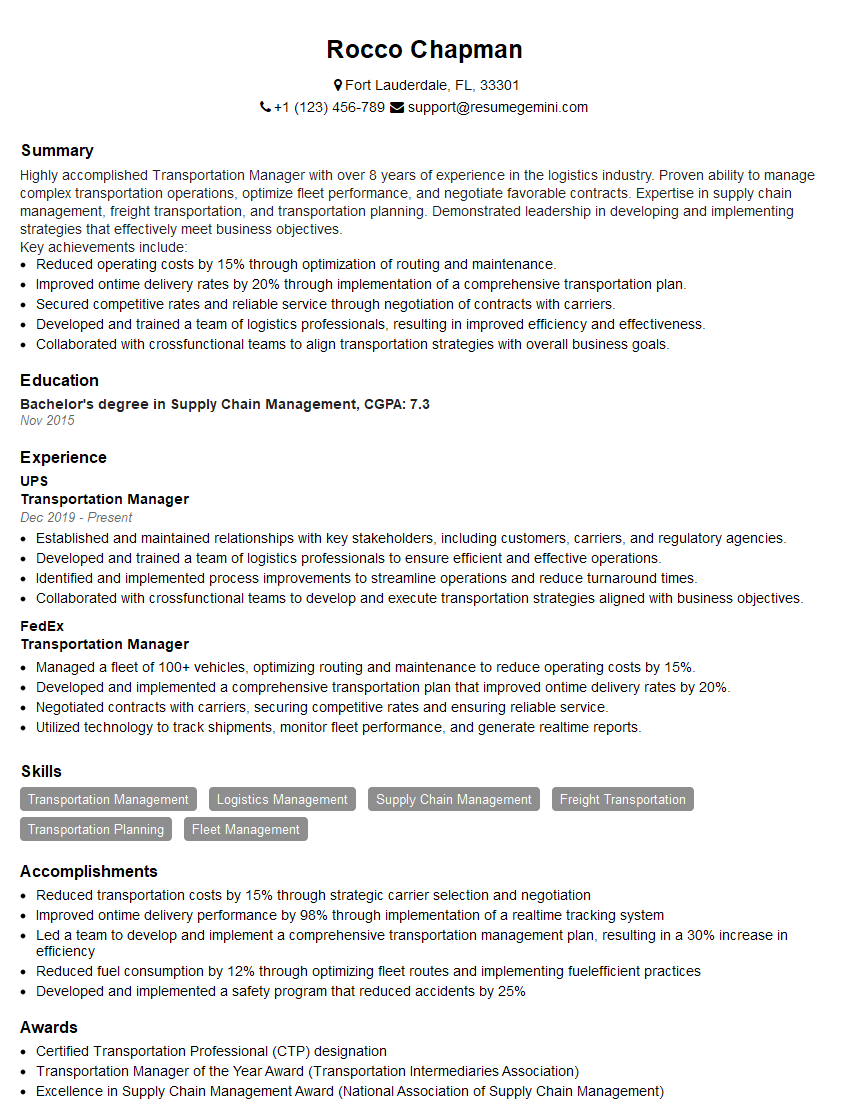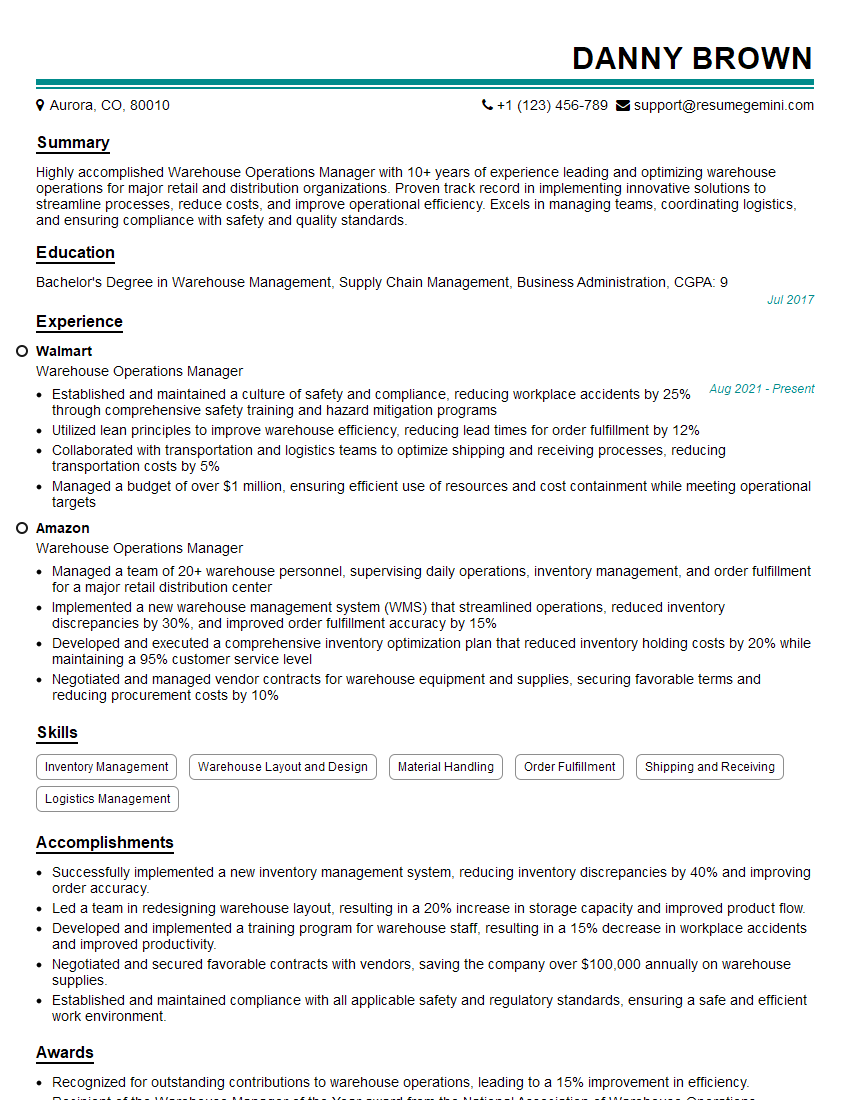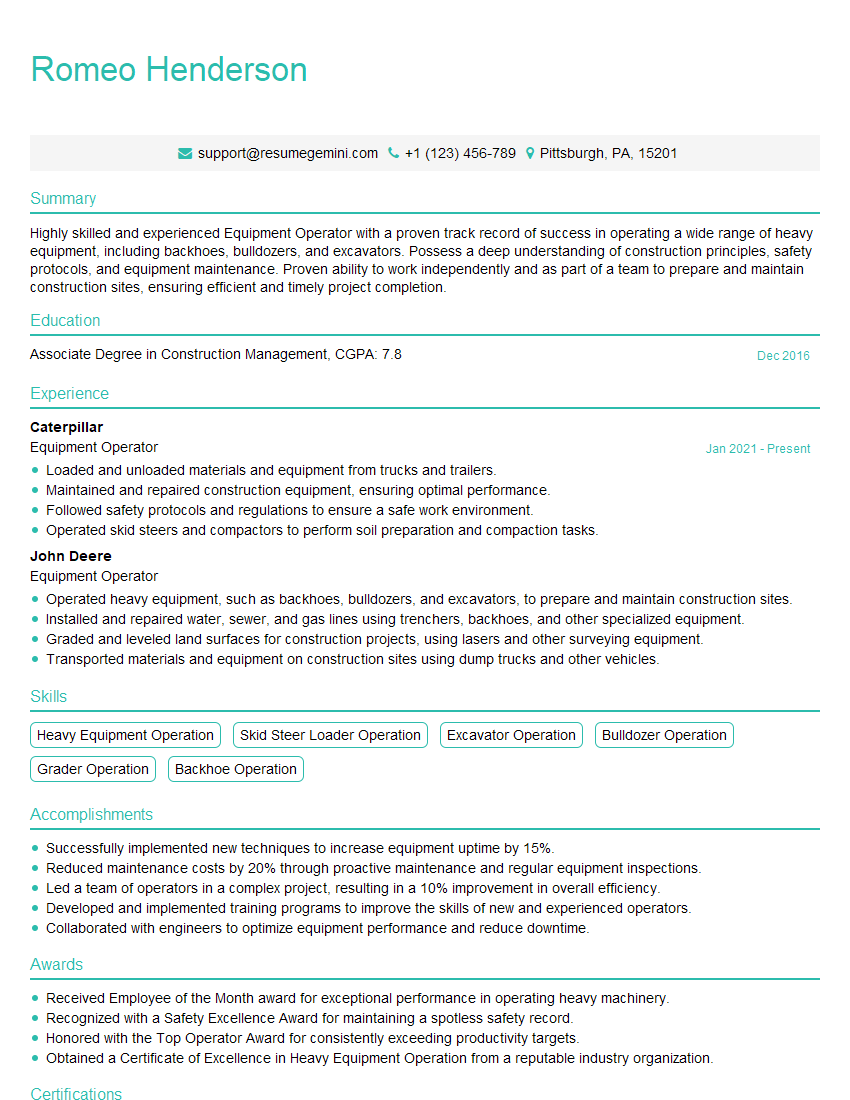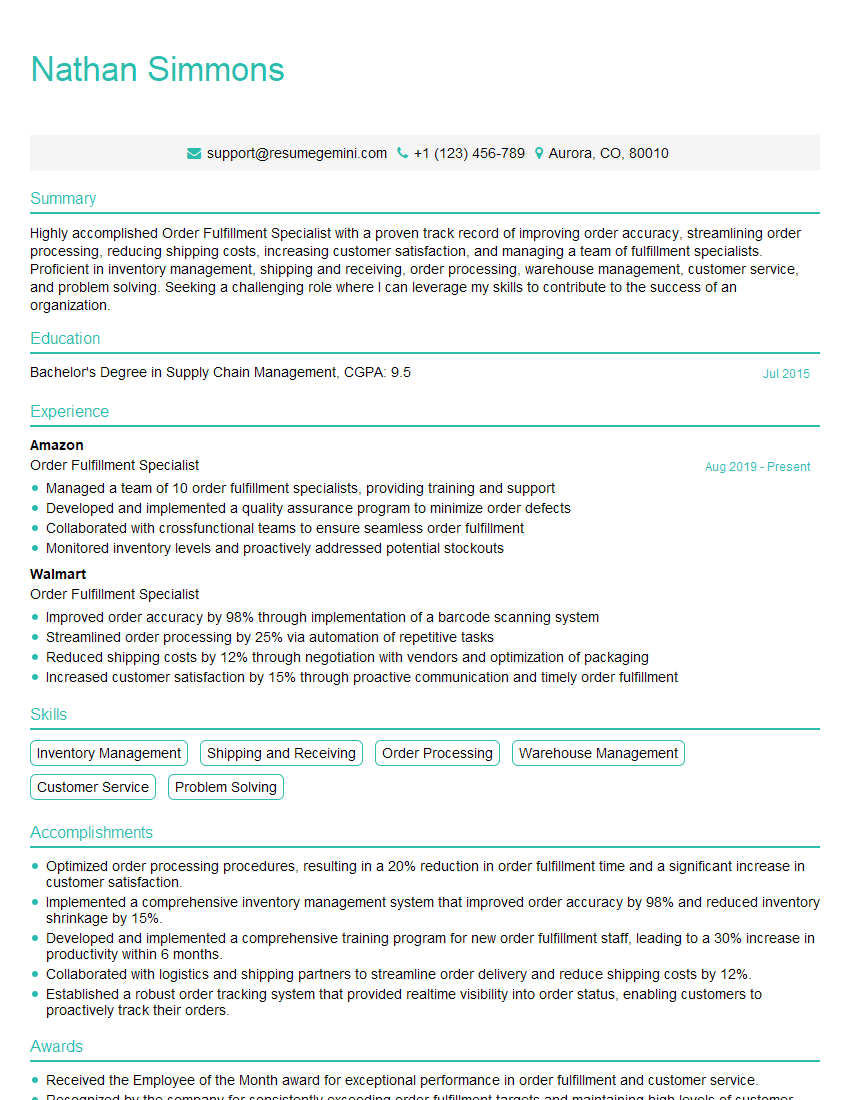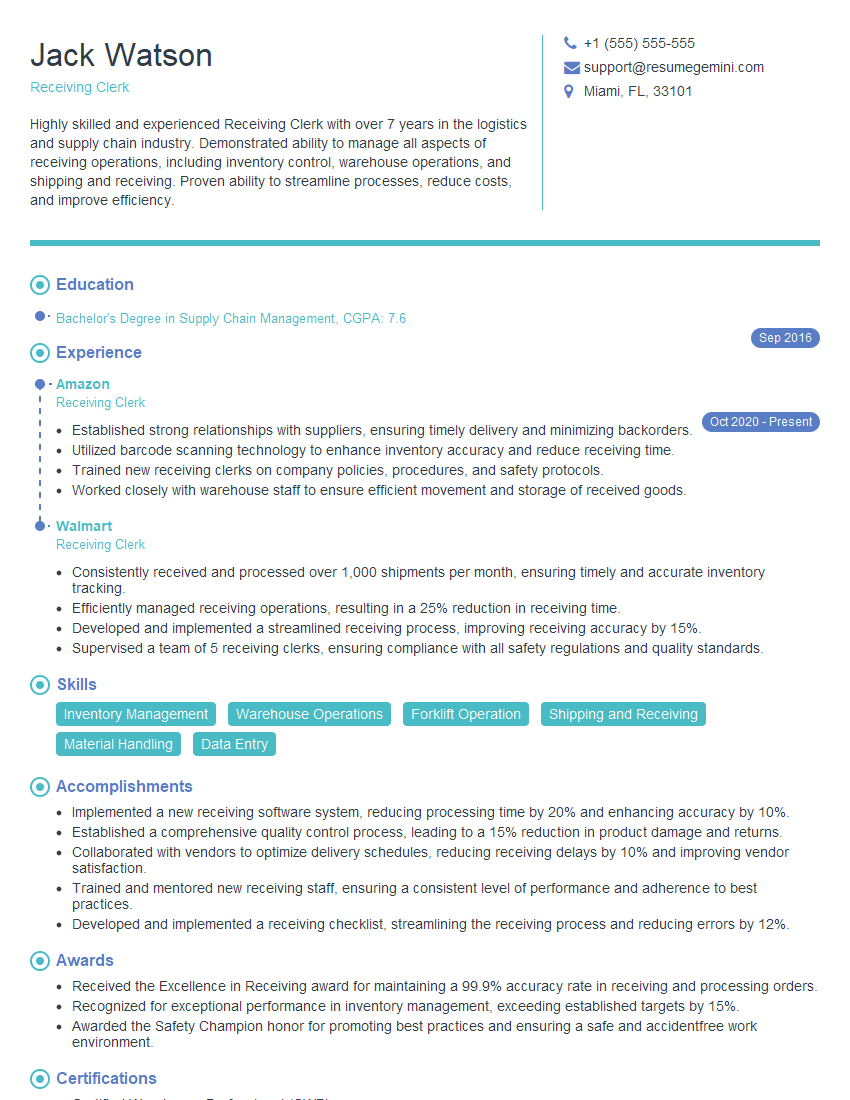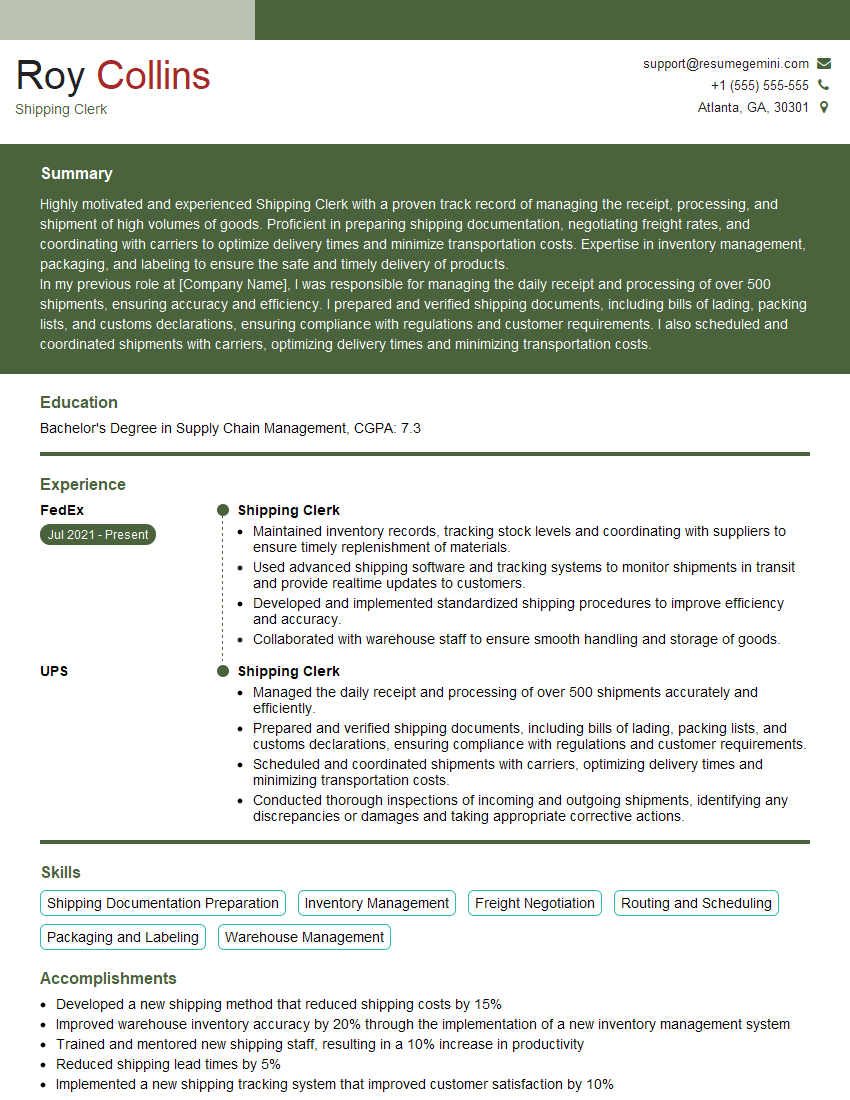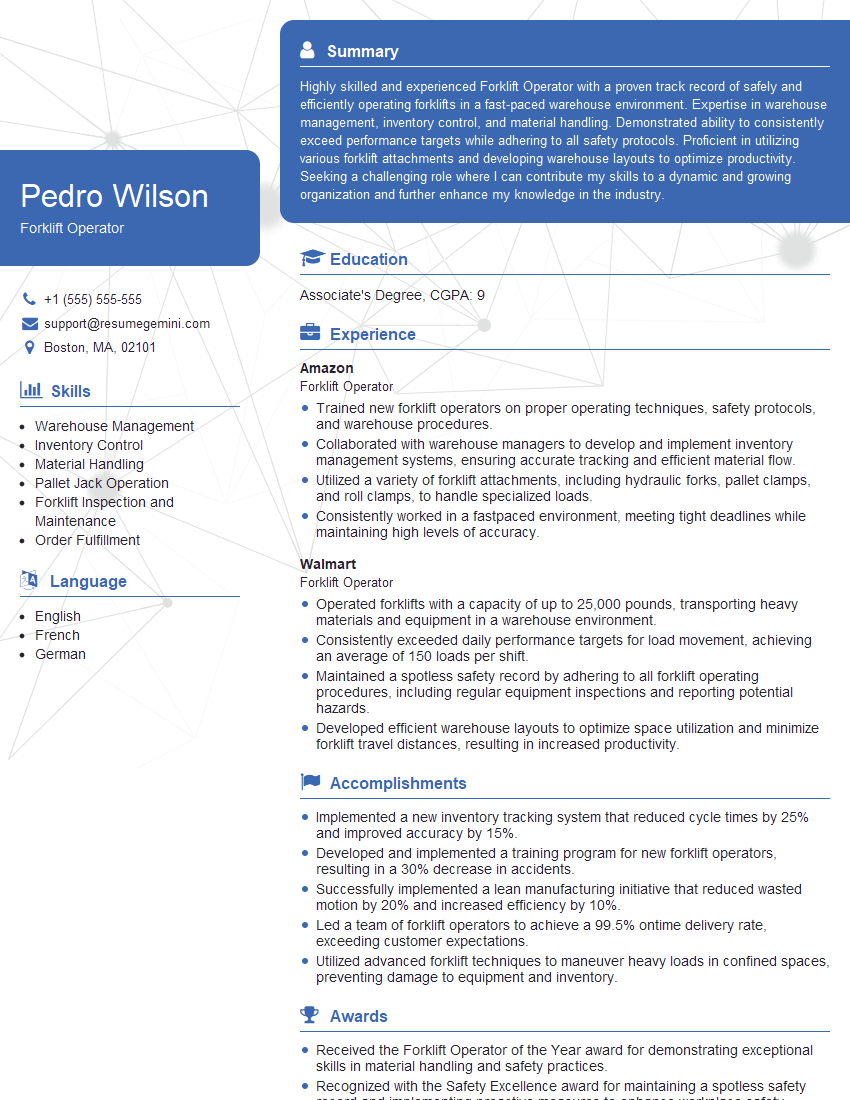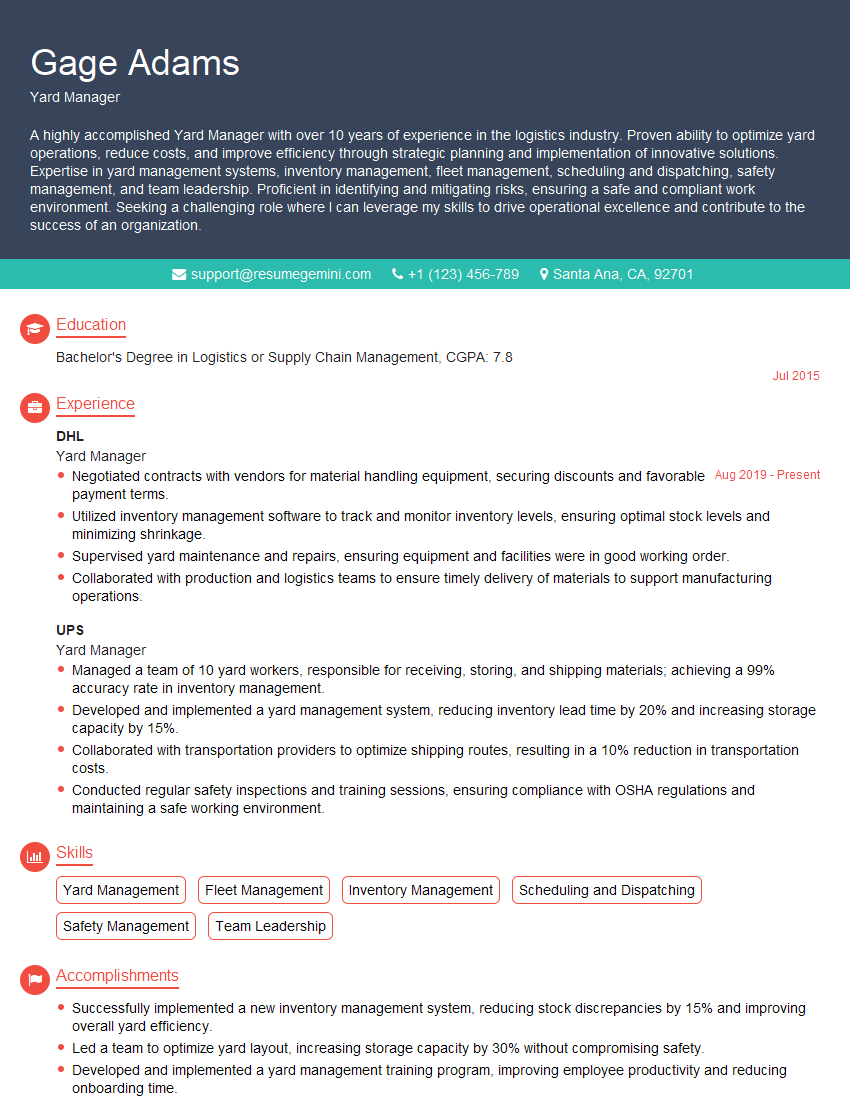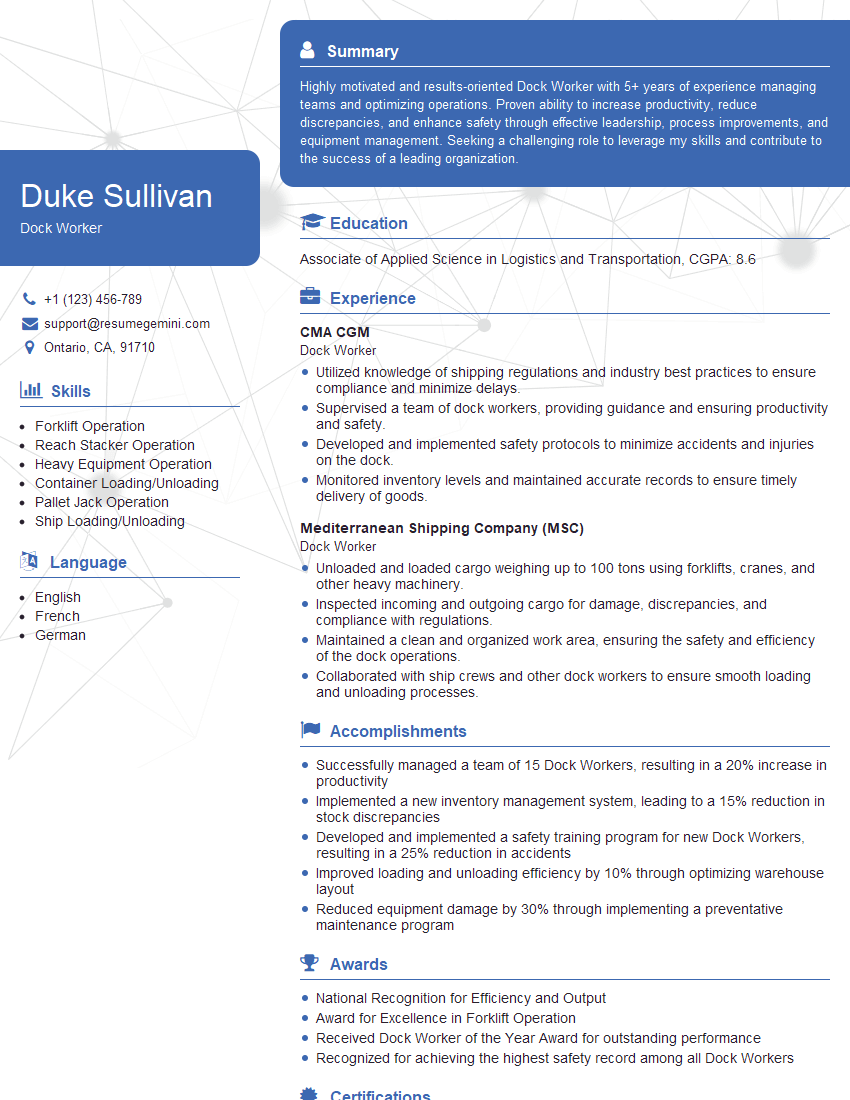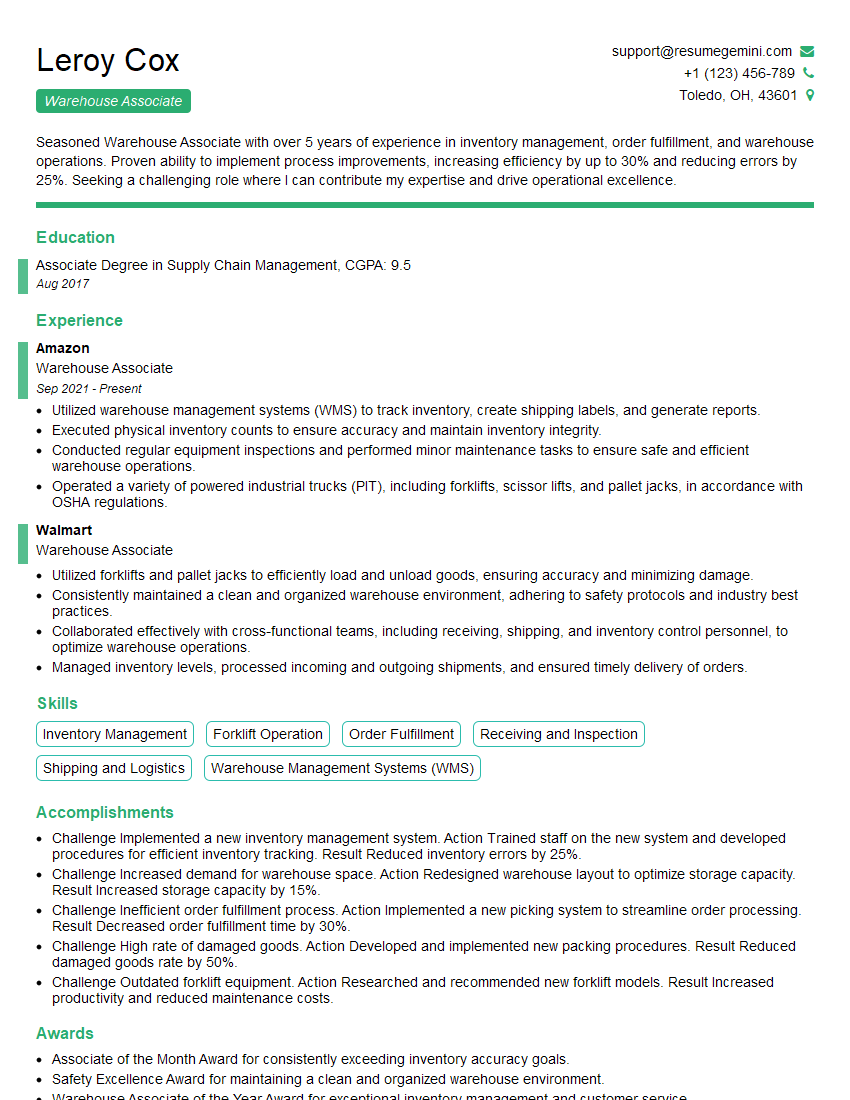Interviews are more than just a Q&A session—they’re a chance to prove your worth. This blog dives into essential Dock Plate Handling interview questions and expert tips to help you align your answers with what hiring managers are looking for. Start preparing to shine!
Questions Asked in Dock Plate Handling Interview
Q 1. What are the different types of dock plates?
Dock plates come in various types, each designed for specific needs and applications. The choice depends on factors like weight capacity, loading dock configuration, and the type of vehicle being used. Here are some common types:
- Steel Dock Plates: These are the most common type, offering high strength and durability. They are available in various sizes and capacities, making them versatile for many applications. Different steel alloys are used for varying levels of strength and resistance to wear.
- Aluminum Dock Plates: Lighter than steel, aluminum dock plates are ideal where weight is a concern, such as in applications involving forklifts or other machinery. They are usually less expensive than steel but might not be as durable under heavy loads or harsh conditions.
- Plastic Dock Plates: Less common, these plates offer good corrosion resistance and are generally lighter. However, they have a lower weight capacity than steel or aluminum, limiting their applications.
- Bridge Plates: These are extra-long and heavy-duty plates, often used to bridge larger gaps between a loading dock and a vehicle.
- Specialty Dock Plates: Some plates are designed with features like beveled edges for easier maneuvering, or non-slip surfaces to enhance safety.
Choosing the right type involves careful consideration of the factors mentioned above. A small warehouse using hand carts might opt for a lightweight aluminum plate, whereas a busy distribution center handling heavy pallets would require robust steel plates.
Q 2. How do you determine the appropriate dock plate capacity for a given load?
Determining the appropriate dock plate capacity is critical for safety and preventing accidents. Never underestimate the load!
You need to calculate the total weight of the load, including the weight of the pallet, goods, and any handling equipment (like a forklift). Add a safety factor – at least 20% above the calculated weight. This accounts for unexpected weight fluctuations or uneven distribution of the load.
For example: If a pallet weighs 2000 lbs, a 20% safety factor adds 400 lbs (2000 x 0.20). The dock plate should have a minimum capacity of 2400 lbs (2000 + 400). Always check the manufacturer’s specifications on the dock plate for the weight capacity and ensure it is clearly marked. The plate’s capacity should be substantially higher than the anticipated maximum load.
If you have any doubts, it’s best to err on the side of caution and use a higher-capacity plate. The consequences of using an inadequately rated plate can be catastrophic.
Q 3. Describe the safety procedures you follow when using a dock plate.
Safety is paramount when using dock plates. Here’s a comprehensive approach:
- Pre-use Inspection: Thoroughly inspect the dock plate for any damage before each use (more details in answer 5).
- Proper Placement: Ensure the plate is securely positioned and fully supported on both the dock and the vehicle’s bed. Avoid overhangs as much as possible.
- Leveling: Ensure the plate is level to prevent tipping or shifting of the load. Use leveling devices if necessary.
- Secure Load: Properly secure the load to prevent it from shifting during transport. This is especially important with heavy or unstable goods.
- Safe Operation of Equipment: Operate forklifts and other equipment carefully near the dock plate, maintaining a safe distance and speed.
- Warning Signs/Communication: Use caution signs and effective communication to alert pedestrians and other workers in the area.
- Personal Protective Equipment (PPE): Ensure everyone involved is wearing appropriate PPE, such as safety shoes and high-visibility vests.
- Training: All personnel involved in loading and unloading should receive proper training on safe dock plate usage.
Treating dock plate usage as a serious safety procedure is crucial to preventing accidents.
Q 4. What are the common causes of dock plate accidents?
Dock plate accidents often stem from negligence or a lack of proper procedures. Common causes include:
- Inadequate Capacity: Using a dock plate with insufficient weight capacity for the load.
- Improper Placement: Incorrect positioning, leading to tipping or overhang.
- Damaged Dock Plate: Using a cracked, bent, or otherwise damaged plate.
- Uneven Surfaces: Placing a plate on uneven surfaces can cause instability.
- Poor Load Securing: Inadequate securing of the load can lead to shifting and accidents.
- Unsafe Equipment Operation: Reckless operation of forklifts or other equipment near the plate.
- Lack of Training: Personnel not adequately trained in safe dock plate procedures.
- Ignoring Warning Signs: Disregarding safety warnings or signs.
Prevention is key. Regular inspections, proper training, and adherence to safety protocols are essential.
Q 5. How do you inspect a dock plate before use?
Before each use, a thorough inspection is mandatory. This involves:
- Visual Inspection: Check the entire surface of the dock plate for cracks, bends, dents, or other visible damage. Pay special attention to the edges and corners.
- Structural Integrity: Verify that the plate is structurally sound and free from any signs of weakness or distortion.
- Lip Condition: Check that the lips or edges of the plate are not damaged or worn, ensuring a safe transition between the dock and the vehicle.
- Safety Features: Inspect any safety features such as non-slip surfaces for damage or wear.
- Capacity Rating: Confirm the weight capacity rating is clearly visible and matches your load requirements.
- Fasteners (if applicable): If the plate has any fasteners, check that they are secure and in good condition.
If any damage is found, the dock plate should be immediately taken out of service and repaired or replaced. A damaged plate poses a significant safety risk.
Q 6. What maintenance procedures are required for dock plates?
Regular maintenance extends the life of dock plates and ensures their continued safe operation. This includes:
- Cleaning: Regularly clean the plate to remove dirt, debris, and any corrosive materials. This prevents rust and damage.
- Inspection: Perform regular inspections, following the steps outlined in the previous answer, to detect any damage early.
- Repair/Replacement: Repair or replace any damaged components promptly. Minor dents might be acceptable, depending on their location, but serious damage necessitates repair or replacement.
- Lubrication (if applicable): If the dock plate uses hinges or other moving parts, regular lubrication is essential to prevent wear and tear.
- Storage: Store the dock plates in a safe, dry location when not in use, protecting them from the elements.
The maintenance frequency depends on the frequency of use and the environment. High-use plates in harsh conditions require more frequent maintenance.
Q 7. How do you handle uneven loading dock surfaces?
Uneven loading dock surfaces pose a significant safety risk when using dock plates. Here’s how to address it:
- Assess the Unevenness: Carefully assess the degree of unevenness. Small discrepancies might be manageable, while significant differences require alternative solutions.
- Leveling Devices: Use shims or other leveling devices to create a level surface under the dock plate. This ensures stability and prevents tilting.
- Ramp Systems: For significant height differences, consider using ramp systems designed to bridge uneven surfaces safely.
- Multiple Plates: In some cases, multiple plates might be necessary to span an uneven surface safely. Ensure proper interlocking or alignment.
- Avoid Use if Necessary: If the unevenness is too extreme or cannot be safely mitigated, avoid using the dock plate altogether. Consider alternative loading/unloading methods.
Always prioritize safety. Never attempt to use a dock plate on a severely uneven surface without taking appropriate corrective actions. The risk of tipping and injury is simply too great.
Q 8. What are the limitations of using a dock plate?
Dock plates, while incredibly useful for bridging gaps between loading docks and vehicles, have inherent limitations. Their primary limitation is their weight capacity. Exceeding the rated capacity can lead to catastrophic failure, resulting in injury or damage. Another limitation is their susceptibility to environmental factors. Exposure to extreme temperatures, moisture, or chemicals can compromise their structural integrity over time. Finally, improper use, such as tilting or using on uneven surfaces, significantly reduces their safety and effectiveness. Think of it like this: a dock plate is only as strong as its weakest point and the care taken in its use.
For example, a dock plate rated for 10,000 lbs should never be loaded with a forklift carrying 12,000 lbs of cargo. Similarly, using a dock plate on a ramp with a significant incline drastically reduces its load-bearing capacity.
Q 9. How do you secure a dock plate to prevent movement?
Securing a dock plate is paramount for safety. The most effective method involves using wheel chocks on the vehicle to prevent it from rolling, and securing the dock plate itself. This usually entails using appropriate restraint devices such as chains or straps, which are properly rated for the weight being handled. These restraints should connect the dock plate to the vehicle or the dock itself, preventing any movement. Additionally, ensuring the dock plate is properly positioned and flush with both the dock and the vehicle is crucial. Think of it as creating a solid, immobile bridge.
For instance, in a warehouse setting, we might use heavy-duty chains to secure a 10,000 lb capacity dock plate to the truck’s frame and the dock edge. The chocks prevent the truck from moving during loading or unloading, and the chains prevent the plate from sliding.
Q 10. What is the proper lifting technique for loading and unloading heavy objects using a dock plates?
Proper lifting techniques when using dock plates are essential to prevent injury and damage. Always use appropriate lifting equipment such as forklifts, pallet jacks, or hand trucks rated for the weight of the load. Never lift beyond the capacity of the equipment or the dock plate itself. Ensure the load is evenly distributed across the plate to prevent uneven stress and potential tipping. Maintain a stable and balanced posture when manually handling lighter objects. Move slowly and deliberately. Using a mechanical lift will also reduce the strain on workers.
For example, when unloading a pallet of heavy boxes, ensure the forklift’s forks are centered on the pallet and that the pallet is placed squarely on the dock plate before lifting. Never attempt to manually lift anything heavier than what’s ergonomically safe.
Q 11. What are the regulations and safety standards related to dock plate usage?
Regulations and safety standards surrounding dock plate usage vary by jurisdiction, but common themes include regular inspection for damage, proper weight capacity labeling and compliance, and training for workers. OSHA (in the US) and similar organizations worldwide provide guidelines on safe lifting practices and equipment use, including the use of dock plates. These standards emphasize the importance of using properly rated equipment, implementing lockout/tagout procedures when performing maintenance, and providing employees with adequate safety training. Failure to comply can lead to serious fines and legal repercussions.
For example, regular visual inspections should be performed before each use, looking for cracks, bends, or other damage. Documentation of these inspections is crucial.
Q 12. How do you address a damaged or malfunctioning dock plate?
A damaged or malfunctioning dock plate should never be used. Immediate action is required. The plate should be clearly marked as ‘out of service’ to prevent accidental use. It needs to be inspected thoroughly to determine the extent of the damage. Minor damage might be repairable, but severe damage necessitates replacement. The damaged dock plate should be removed from service and reported to the appropriate personnel for repair or disposal. A replacement should be sourced that meets the same or higher safety and weight requirements.
Imagine finding a crack in a dock plate—immediately take it out of service, report it, and await replacement to avoid a potential accident.
Q 13. Explain the process of installing and removing a dock plate.
Installing a dock plate typically involves positioning it correctly to ensure a seamless transition between the dock and the vehicle bed. The plate should be firmly placed, aligning with both surfaces to avoid any gaps or misalignments that could cause instability. Removal involves the reverse process, carefully lifting the plate and ensuring it’s stored in a safe and protected area away from traffic and hazards. Always double-check that the plate is free of obstructions and is correctly secured during both installation and removal.
Think of it as building a temporary bridge—ensure it’s correctly placed, stable, and carefully removed once the job is done.
Q 14. How do you communicate safety procedures to co-workers regarding dock plates?
Communicating safety procedures to coworkers is crucial. This should involve regular training sessions and toolbox talks that cover the proper use and limitations of dock plates, inspection procedures, weight capacity limits, and the importance of securing the plates. Visual aids such as posters and checklists can reinforce these procedures. Regular reminders and open communication channels should be maintained to ensure everyone understands and adheres to safety protocols. Encourage workers to report any concerns or incidents promptly.
For example, a weekly toolbox talk could cover a specific aspect of dock plate safety, such as proper securing techniques or identifying signs of damage. Regular quizzes and refresher training can also ensure continued understanding.
Q 15. Describe your experience with different types of dock plate materials (e.g., steel, aluminum).
My experience encompasses a wide range of dock plate materials, each with its own strengths and weaknesses. Steel dock plates are the industry standard, known for their exceptional durability and high weight capacity. They are ideal for heavy-duty applications and can withstand significant wear and tear. However, they are heavier than other options, making them less maneuverable. Aluminum dock plates, on the other hand, offer a lighter-weight alternative, making them easier to handle and position. They’re a good choice when weight is a significant factor, such as in applications with limited overhead capacity. However, aluminum is less resistant to dents and scratches than steel, and its weight capacity is generally lower. I’ve also worked with composite materials, which combine the benefits of both steel and aluminum – offering a good balance of strength and lightweight design.
For example, in a recent project involving loading heavy machinery, the robust nature of steel dock plates was crucial for safety. Conversely, when working with a loading dock in a delicate historic building, the lighter aluminum plates allowed us to minimize stress on the existing structure.
Career Expert Tips:
- Ace those interviews! Prepare effectively by reviewing the Top 50 Most Common Interview Questions on ResumeGemini.
- Navigate your job search with confidence! Explore a wide range of Career Tips on ResumeGemini. Learn about common challenges and recommendations to overcome them.
- Craft the perfect resume! Master the Art of Resume Writing with ResumeGemini’s guide. Showcase your unique qualifications and achievements effectively.
- Don’t miss out on holiday savings! Build your dream resume with ResumeGemini’s ATS optimized templates.
Q 16. What is your experience with different dock plate sizes and weight capacities?
My experience covers a broad spectrum of dock plate sizes and weight capacities. Dock plates come in various lengths, widths, and thicknesses, each designed to support a specific weight load. I’ve worked with plates ranging from smaller units suitable for light-duty applications and hand trucks to massive plates capable of supporting tens of thousands of pounds and accommodating heavy industrial vehicles. The selection process always starts with a thorough assessment of the anticipated load, truck types, and dock conditions.
For instance, a standard 72” x 48” steel dock plate might have a capacity of 10,000 lbs., while a larger, reinforced plate could support 20,000 lbs or more. Understanding these weight capacities is crucial for safety and preventing accidents.
Q 17. How do you ensure the compatibility of a dock plate with different types of trucks?
Ensuring compatibility between dock plates and various truck types is paramount. It’s not just about weight capacity; the height of the truck bed relative to the dock level must also be considered. Incorrectly sized dock plates can create unsafe gaps, posing risks for both personnel and equipment. We assess the gap between the truck bed and the dock, selecting a plate that bridges the difference safely. Factors like the truck’s wheelbase and the location of the loading area also inform the plate selection process. We often use different sized plates depending on the type of vehicle, sometimes employing multiple plates to create a safe and stable loading platform. This can include using ramps and additional support to create a safe loading or unloading solution.
For example, a low-profile truck might require a shorter dock plate, whereas a high-bed truck will need a longer one to bridge the gap. We also always check the plate’s load rating to ensure it exceeds the weight of the cargo being handled.
Q 18. Describe your experience with dock levelers and their interaction with dock plates.
Dock levelers are integral to efficient and safe loading and unloading, working in conjunction with dock plates. The leveler adjusts for variations in truck bed height, creating a level surface. The dock plate then provides the bridge between the leveler and the truck. This interaction necessitates careful coordination to ensure seamless transitions and prevent accidents. It’s vital that the dock plate is correctly positioned and secured on the leveler before any vehicles are moved. Understanding the weight capacity and operational limitations of both the leveler and the dock plate is crucial for safe operation. I’ve worked with various leveler types, hydraulic, mechanical, and edge-of-dock, and have experience in troubleshooting their various malfunctions.
One common scenario involves aligning the dock plate perfectly with the lip of the leveler, ensuring that there’s no gap which can cause equipment or cargo damage, and ensuring that the dock plate is firmly seated for a safe loading process.
Q 19. How do you handle emergency situations involving dock plates?
Emergency situations involving dock plates require immediate and decisive action. This could range from a plate becoming damaged or dislodged during loading to an accident involving personnel. My protocol begins with immediate evacuation of the area to ensure everyone’s safety. Then I assess the situation, determining the extent of the damage or the nature of the accident. Depending on the situation, this might involve contacting emergency services, securing the area to prevent further accidents, and implementing temporary solutions to halt operations until the situation is rectified. If the plate is damaged, it is immediately removed from service, and a replacement of proper size and capacity is installed. A detailed report must be filed for any incident to ensure preventative measures can be put in place.
For example, if a plate were to fail under heavy load, the immediate priority would be to ensure no one is injured and to prevent further damage by swiftly securing the immediate area and contacting emergency responders as needed.
Q 20. What are the common issues related to dock plate alignment and how do you resolve them?
Misaligned dock plates are a significant safety hazard. They can cause equipment damage, cargo damage, and even injuries. Common causes include improper placement, uneven surfaces, and worn-out levelers. Resolving alignment issues starts with a careful inspection, identifying the root cause. This might involve verifying the leveler’s functionality, checking for obstructions beneath the plate, or ensuring the surface is level and free from debris. If the problem stems from the plate itself, it may need to be repositioned or replaced. For example, a simple adjustment of the leveler can often solve minor alignment problems. More serious issues, such as a damaged or worn-out leveler or damaged plate, necessitate repairs or replacement.
I typically use a combination of visual inspection, level tools, and sometimes a slight adjustment of the leveler to achieve precise alignment. This often involves teamwork with fellow dock workers or forklift operators to safely maneuver the plates.
Q 21. How do you train new employees on the safe operation of dock plates?
Training new employees on dock plate safety is a crucial aspect of my role. The training program I utilize is comprehensive, covering theoretical knowledge and practical application. We start with a detailed explanation of different dock plate types, sizes, and weight capacities. We then cover the importance of proper alignment, the procedures for safe loading and unloading, and the recognition of potential hazards. Hands-on training is crucial, involving demonstrations and supervised practice under controlled conditions. This includes using various types of dock plates with different trucks and handling both routine and emergency scenarios. Following this, I provide clear guidelines for reporting incidents and conducting regular equipment inspections.
Practical demonstrations, for example, show how to correctly position a dock plate to avoid gaps and how to assess the stability of the loading operation. Regular quizzes and practical tests ensure comprehensive understanding and retention of the crucial safety guidelines.
Q 22. Describe a time you had to troubleshoot a problem with a dock plate.
One time, I was supervising the loading of a pallet of delicate ceramic vases. The dock plate, a heavy-duty steel model, was showing signs of sticking – it wasn’t retracting smoothly into its stowed position after unloading. This delayed operations and risked damage to both the plate and the dock itself. My troubleshooting involved several steps. First, I visually inspected the plate for any obvious obstructions, like debris or damage. Finding none, I then checked the hydraulic system (assuming a hydraulically assisted dock plate), looking for leaks or low fluid levels. The issue turned out to be a build-up of grime in the mechanism’s moving parts. A thorough cleaning with a degreaser and a wire brush, followed by lubrication, solved the problem. We also implemented a daily inspection routine to prevent this issue from recurring. This experience highlighted the importance of proactive maintenance and the need to address even seemingly minor issues promptly to avoid significant operational delays or costly repairs.
Q 23. What are the potential hazards associated with improper dock plate use?
Improper dock plate use presents several serious hazards. The most significant is the risk of falls. An improperly positioned or damaged dock plate can create a dangerous gap between the truck and the loading dock, leading to falls by workers or the accidental tipping of equipment. Crushing injuries can occur if the plate shifts unexpectedly during loading or unloading, trapping limbs or people. Damage to goods can result from uneven surfaces or insufficient weight capacity of the plate. Furthermore, structural damage to both the loading dock and the truck can occur if the plate is overloaded or improperly used. Finally, back injuries are common if workers use improper lifting techniques when loading or unloading across a dock plate. Safe operation relies on proper training, regular inspections, and adherence to weight limits.
Q 24. How do you ensure that the dock plate is properly positioned before loading or unloading?
Ensuring proper dock plate positioning is crucial for safety and efficiency. Before any loading or unloading begins, I always follow a specific checklist:
- Visual Inspection: Check for any damage or debris on the dock plate itself and the surrounding area.
- Gap Assessment: Ensure the plate bridges the gap between the loading dock and the truck bed smoothly and without significant gaps, ideally with less than a 1/4 inch gap.
- Secure Placement: Verify that the plate is firmly and correctly secured to both the truck bed and the dock, using any locking mechanisms provided.
- Level Check:Confirm that the dock plate is level to prevent instability and damage to goods and equipment. A slight incline is generally acceptable but large disparities should be corrected.
- Weight Capacity: Always verify that the dock plate’s weight capacity exceeds the combined weight of the goods, equipment, and personnel involved.
If anything seems amiss, I never hesitate to halt operations and address the issue before proceeding. This thorough approach ensures a safe and efficient loading/unloading process.
Q 25. How do you prevent damage to the dock plate and the surrounding area?
Preventing damage to the dock plate and its surroundings requires a multi-pronged approach. Firstly, regular inspections are critical. We look for signs of wear and tear, including dents, scratches, or cracks. Secondly, proper lifting techniques are emphasized and trained. Avoid dropping heavy loads directly onto the plate, instead using appropriate lifting equipment and lowering procedures. Thirdly, we ensure the correct weight capacity is never exceeded, and we make use of load spreaders or other techniques to distribute the load evenly across the plate. Regular cleaning removes debris that can cause damage to the plate’s surface and mechanisms. Fourthly, secure the dock plate properly according to the manufacturer’s instructions. And finally, we encourage reporting of any damage immediately to prevent further problems.
Q 26. How do you manage the risk of slips, trips, and falls around dock plates?
Managing slips, trips, and falls around dock plates necessitates a proactive approach. This begins with ensuring the area is kept clean and free of debris. Spill response protocols should be in place and adequately trained personnel should be available to immediately address any spills. Proper lighting is also essential, especially in low-light conditions. Good housekeeping is critical – things like cables, pallets, and tools should be properly stored and organized to avoid trip hazards. We also emphasize the use of appropriate footwear with good traction. Finally, providing workers with safety training regarding safe movement around dock plates and proper loading/unloading procedures significantly reduces the risk of accidents. Regular inspections further help proactively identify and remedy potential hazards.
Q 27. Explain the difference between a bridge plate and a dock leveler.
While both bridge plates and dock levelers facilitate the transfer of goods between trucks and loading docks, they differ significantly in design and function.
- Bridge Plates: These are essentially ramps, typically made of steel, designed to bridge a relatively small gap between a truck and the dock. They are simpler in design and typically have a fixed incline. They are suitable for smaller gaps and lighter loads.
- Dock Levelers: These are more complex and sophisticated systems that mechanically adjust to the height of the truck bed, creating a level surface. They often feature a lip that prevents gaps and are capable of handling significantly heavier loads. Dock levelers are essential for efficient loading and unloading of larger trucks and heavier goods.
Think of a bridge plate as a simple ramp, good for smaller gaps, while a dock leveler is a more robust, adjustable platform ideal for handling larger and heavier loads and bridging larger gaps more safely and efficiently.
Key Topics to Learn for Dock Plate Handling Interview
- Weight Capacity and Load Distribution: Understanding safe weight limits, proper load centering, and the impact of uneven weight distribution on dock plate stability.
- Types of Dock Plates: Familiarize yourself with various dock plate materials (steel, aluminum), sizes, and their suitability for different applications (e.g., forklift capacity, surface conditions).
- Safe Handling Procedures: Mastering techniques for proper placement, securing, and removal of dock plates to prevent accidents and damage. This includes understanding lip heights and gap considerations.
- Inspection and Maintenance: Recognizing signs of wear and tear, damage, and necessary maintenance procedures to ensure continued safe operation. Knowing when to replace a damaged dock plate is crucial.
- Safety Regulations and Compliance: Familiarity with relevant OSHA or industry-specific safety regulations pertaining to dock plate usage and handling.
- Problem-Solving Scenarios: Prepare to discuss how you would handle situations like uneven surfaces, damaged plates, or unexpected weight shifts. Focus on demonstrating your problem-solving skills and commitment to safety.
- Forklift Interaction: Understanding safe operating procedures when using forklifts in conjunction with dock plates, including proper maneuvering and avoiding damage.
Next Steps
Mastering dock plate handling techniques is essential for a successful career in logistics, warehousing, and shipping. A strong understanding of safety procedures and practical application will set you apart. To maximize your job prospects, create an ATS-friendly resume that highlights your skills and experience. ResumeGemini is a trusted resource that can help you build a professional and impactful resume, tailored to the specific requirements of Dock Plate Handling roles. Examples of resumes specifically designed for Dock Plate Handling positions are available to guide you. Take the next step towards your dream job – build a compelling resume with ResumeGemini today!
Explore more articles
Users Rating of Our Blogs
Share Your Experience
We value your feedback! Please rate our content and share your thoughts (optional).
What Readers Say About Our Blog
good

